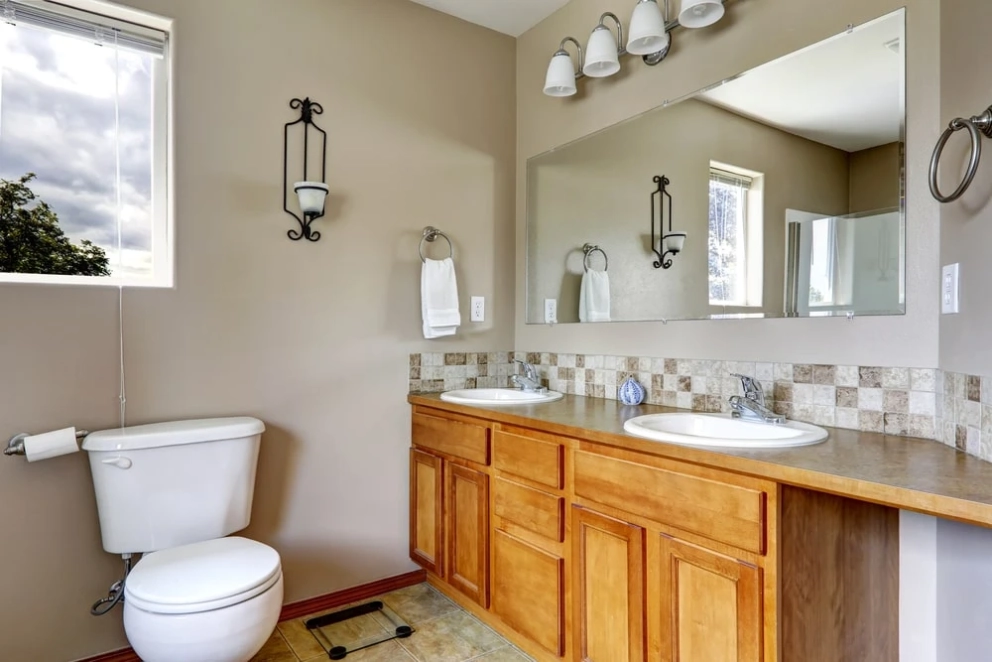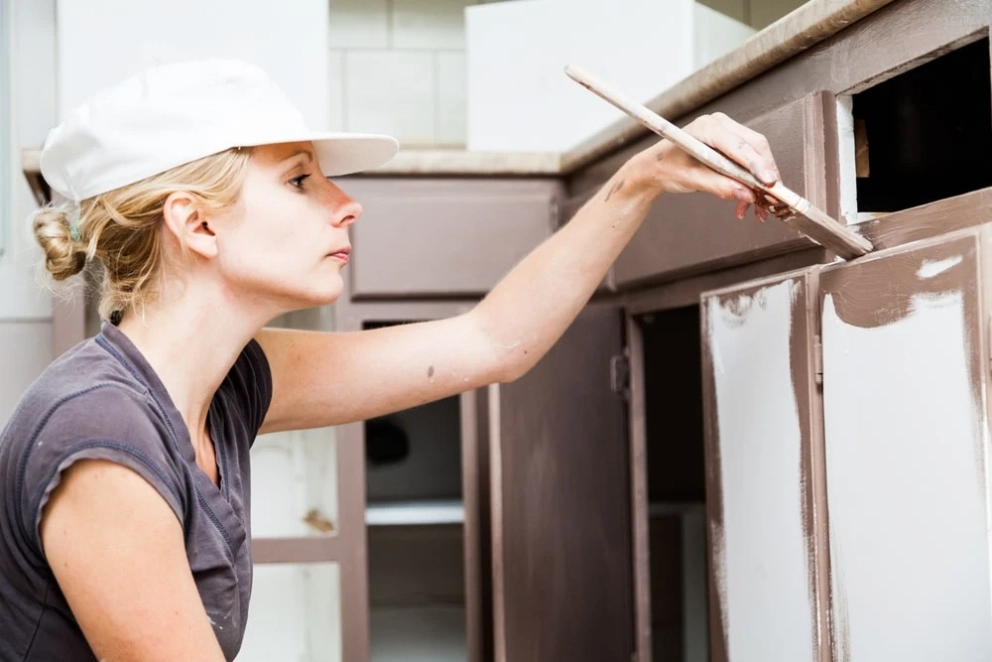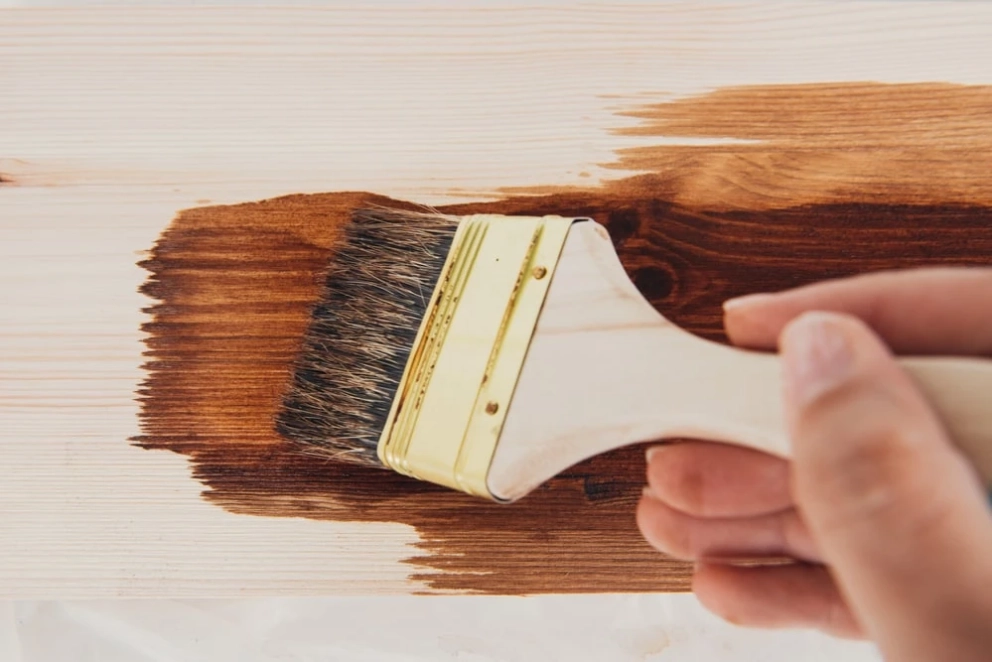Waterproofing Bathroom Cabinets. How to Protect Bathroom Cabinets from Water?

Cabinets such as vanities, tallboys or shaving cabinets are common in bathrooms. They are required for many purposes, like storing toiletries and towels, providing us with countertops and drawers, or offering comfy shelves exactly where we need them. At the same time, the bathroom is the most humid room with extreme temperature fluctuations. Such conditions are a big challenge for every piece of cabinetry, whether wooden or wood substrates like plywood or MDF. Even the most durable finishing can suffer from heat and moisture after a few years, so choosing waterproof bathroom cabinets and further protecting them from damage is the key to their longevity.
The most common materials for vanities include wood, plywood particleboard and MDF. All these materials need to be properly sealed and waterproofed. You should choose the right materials and finish coating for your bathroom unit based on the size of the room, the ventilation capacity, and the level of humidity. In the current Cut2Size post, we are going to range the best cabinet materials for the bathroom environment. We’ll discuss how to know if your bathroom cabinets and vanity suffer from high humidity, and share useful tips on how to avoid water damage and maintain their good shape for a long stay.
Types Of Bathroom Cabinets

Before anything else, it is important to identify what type of bathroom cabinetry you have in your home. There are basically different types of bathroom cabinets. These are the following:
- Under-the-sink cabinet
Under the sink cabinet is a cabinet that is designed together with the sink. The style of the cabinet depends on the type of sink to be installed since the cabinet basically serves as the cover that will conceal the plumbing system of the sink. It also has no back panel.
Waterproofing sink cabinet is challenging because the plumbing is in direct contact with the cabinet. But sink cabinet waterproofing is doable. When waterproofing a cabinet under the sink, make sure to seal the area around the sink with caulk. A waterproof bathroom sink cabinet will spare you the aggravation and additional costs of dealing with a water-damaged cabinet in the future.
- Countertop in bathroom
The beauty and charm of the wooden countertop in the bathroom are unarguable. But like all wooden materials, there are a couple of downsides that you will experience along the way by having wooden countertops in areas that are prone to moisture and water damage – like bathrooms and kitchens. Always waterproof bathroom countertop to avoid damage. How to seal wood countertops in the bathroom? You can do this by waterproofing the butcherblock countertop in the bathroom. You may use butcher block oil to waterproof the wood bathroom countertop, just like you would for cutting boards. However, keeping the water-resistant seal requires frequent maintenance.
- Bathroom storage cabinets
Storage cabinets in bathrooms can come in many forms. In small bathrooms, for example, bathroom wall cabinets are deemed ideal. Floating shelves, and open racks, among others, are a few examples. Even though your only storage is an open shelf, you still need to waterproof it. Waterproof bathroom storage cabinets and waterproof shelves are something that every homeowner should do when installing cabinets regardless of how small your storage space is. Waterproof shelves in the bathroom by coating them with a spray-on rubber coating and sealing it with polyurethane.
- Vanity units
A vanity unit is a type of furniture that integrates a bathroom sink and cabinets into one convenient design. Vanity units come in a number of different forms to fit into every bathroom, from powder rooms to luxurious master bathrooms. One of the common questions we often get asked is: Are bathroom vanities waterproof? Some bathroom vanities are waterproof depending on the manufacturer of the furniture. Wet vanities for example are waterproofed by the manufacturer because this type of vanity is usually used in wet rooms. Waterproofing bathroom vanity units is also something you can do yourself. How to waterproof a bathroom vanity? Using a water-resistant coating on the cabinet's surface is the easiest approach to waterproofing a bathroom vanity. These may be found at most reputable home improvement stores, but you'll need to prepare the cabinet beforehand.
Waterproofing Materials for Bathroom

Waterproofing a bathroom starts with your choice of materials. If you select a material that is naturally resistant to water, the less maintenance and protection it will require you to waterproof it. To give you a bit of a background on these materials, we created a table showing the characteristics, advantages, and disadvantages of some of the most common types of wood for bathroom cabinets.
| Materials | Definition | Advantage | Disadvantage |
| MDF | MDF (Medium Density Fibreboard) is a type of engineered wood that is frequently used in bathroom cabinets. MDF is made up of composite fibres and tiny bits of wood that are glued or waxed together. | MDF cabinets for bathrooms is cheaper than other types of wood. It also has a smooth surface which is great for applying paint, sealer for waterproofing MDF cabinet doors, and other finishes. | IS MDF good for bathroom cabinets? It should be emphasized that, regardless of the process, MDF is moisture-resistant, not waterproof, and remains susceptible to swelling and warping when exposed to the environment. |
| Solid wood | Solid wood is a popular choice for wooden bathroom cabinets because of its natural aesthetic appeal. Solid wood is made from trees that have been processed directly. | It is considered that wood is best for bathroom cabinets because it is durable, beautiful, and has the potential to increase the value of a home. | Not a water-resistant wood for a bathroom but can be waterproofed when finished and sealed properly. |
| Plywood | Plywood, which is made up of numerous wood veneers bonded together to form stacked sheets, is another common material used to make bathroom cabinets. | Plywood bathroom cabinets are common because When it comes to cabinet construction, plywood is typically believed to be the superior material. It retains screws and fasteners better and has a longer lifespan in construction. | Plywood's ends and edges are susceptible to water damage, and it never has the same feel as solid wood. You can, however, waterproof the plywood bathroom vanity to protect it from moisture and damage. |
| PVC | PVC is a form of plastic that is utilized in a wide range of applications in the kitchen, bathroom, and vanity. | PVC has a 100 percent water resistance and can last for a long period of time. | The downside of PVC cabinets is that they require a qualified carpenter to install them. Shutters and drawers might even droop if the planks are screwed in incorrectly. |
| Laminate | Laminate is made up of synthetic materials that are layered to seem like wood. A printing method gives the laminate its wood grain texture. | Laminate cabinets are less expensive than wood cabinets and are simple to maintain. They're also less prone to damage, making them an excellent choice for families with young children. | Laminate is constructed from reclaimed timber and is therefore not waterproof. It features a strong surface that resists scratches but provides minimal water resistance. |
Bathroom Cabinet Finishes
The finishes on bathroom cabinets are crucial for their durability and longevity. There are many types of finishes to choose from, and the best one depends on the needs of your home.

- High-gloss cabinets
High gloss paint is recognized for being extremely bright and light-reflecting, almost crystal clear in appearance. Because of the beautiful lustre it produces, most designers would consider it an ideal finish for surfaces like cabinet doors, countertops, and wooden furniture. Interior paint with a high gloss finish is usually water-resistant. While the glossy finish may expose fingerprints and other surface defects, it does not absorb oils or grime easily.
- Semi-gloss bathroom cabinets
Semi-gloss is sometimes likened to satin, although it has significantly more shine. As a result, light from windows and lighting fixtures will reflect off semi-gloss paint more effectively than light from eggshell or satin paint. It works well in locations with increased humidity, such as bathrooms, kitchens, and laundry rooms, as well as high-traffic areas like doors and utility rooms, because of its strong moisture resistance.
- Laminate cabinets
Laminates are a type of synthetic composite material commonly used in prefabricated kitchen cabinets. Squeezing together layers of flattened plastic and paper resins, with the top layer etched with a fashionable look or colour, produces this material. To waterproof laminate cabinets, Apply a high-quality polyurethane sealant around the sharp corners of your cabinets to keep water out. Liquid polyurethane, whether in your bathroom or under the sink cabinet, is a fantastic product that may save you a lot of time and money in the long run.
- Varnished cabinets
Varnish can protect wooden surfaces from scratches in addition to waterproofing them. Using a solution like a varnish to finish wood protects it from the inevitable scrapes and spills that occur in a busy household. Varnish is generally utilized as a wood finish where the various tones and grains of the wood are desired to be apparent, whether stained or not. Varnishes come in a variety of sheens, including satin, semi-gloss, and flat.
- Lacquer bathroom cabinets
Lacquer is a contemporary wood treatment that is frequently used on luxurious furniture. It dries quickly, is water-resistant, and retains its clarity over time. Lacquer finishes are preferred because they do not discolor with time, are water-resistant, and need little upkeep.
- Contact paper bathroom cabinets
Contact paper is also known as adhesive paper. It is a glossy, waterproof surface and a sticky backing that is sealed by a protective coating. The quality and durability of contact paper vary significantly. Although some contact paper is heat and water-resistant, others can be easily damaged.
Waterproofing a painted cabinet is a task that you can DIY. As long as you know the steps how to do it, including the basic information about the cabinet materials, paints, and finishes, you can waterproof paint for bathroom cabinets with ease.



